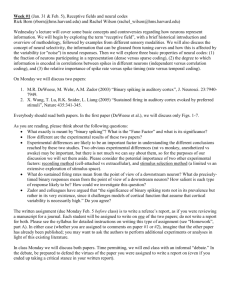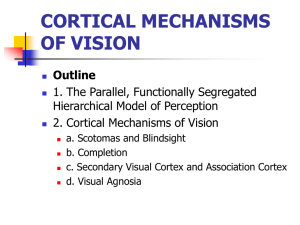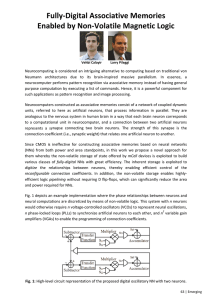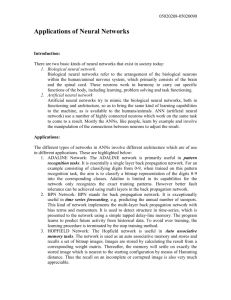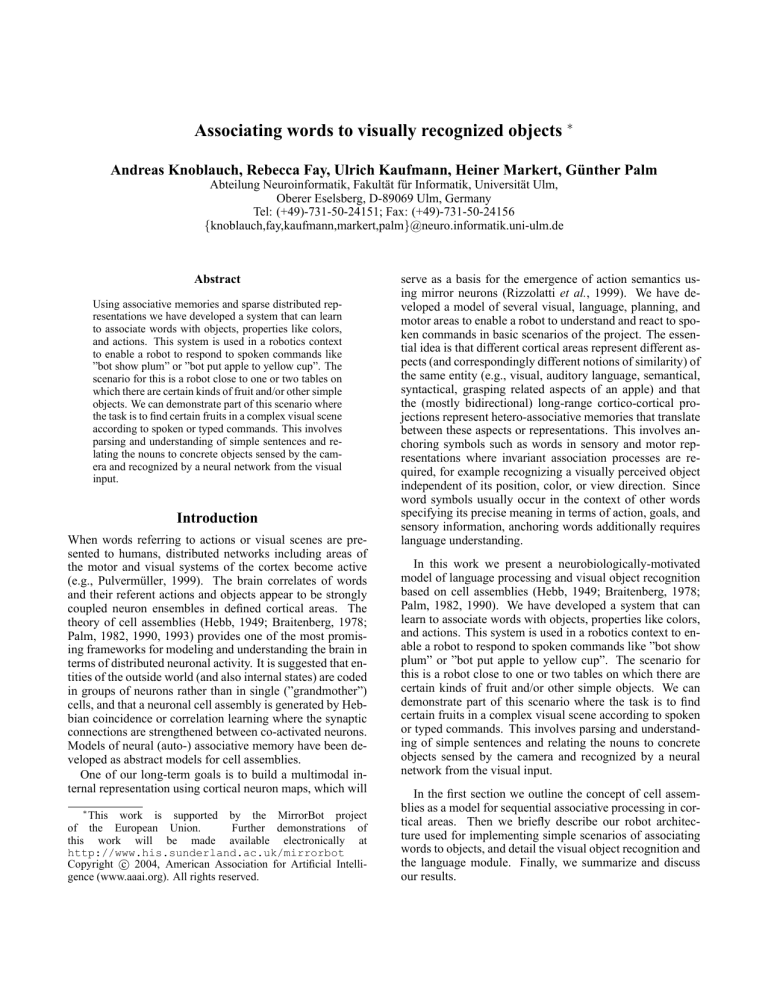
Associating words to visually recognized objects ∗
Andreas Knoblauch, Rebecca Fay, Ulrich Kaufmann, Heiner Markert, Günther Palm
Abteilung Neuroinformatik, Fakultät für Informatik, Universität Ulm,
Oberer Eselsberg, D-89069 Ulm, Germany
Tel: (+49)-731-50-24151; Fax: (+49)-731-50-24156
{knoblauch,fay,kaufmann,markert,palm}@neuro.informatik.uni-ulm.de
Abstract
Using associative memories and sparse distributed representations we have developed a system that can learn
to associate words with objects, properties like colors,
and actions. This system is used in a robotics context
to enable a robot to respond to spoken commands like
”bot show plum” or ”bot put apple to yellow cup”. The
scenario for this is a robot close to one or two tables on
which there are certain kinds of fruit and/or other simple
objects. We can demonstrate part of this scenario where
the task is to find certain fruits in a complex visual scene
according to spoken or typed commands. This involves
parsing and understanding of simple sentences and relating the nouns to concrete objects sensed by the camera and recognized by a neural network from the visual
input.
Introduction
When words referring to actions or visual scenes are presented to humans, distributed networks including areas of
the motor and visual systems of the cortex become active
(e.g., Pulvermüller, 1999). The brain correlates of words
and their referent actions and objects appear to be strongly
coupled neuron ensembles in defined cortical areas. The
theory of cell assemblies (Hebb, 1949; Braitenberg, 1978;
Palm, 1982, 1990, 1993) provides one of the most promising frameworks for modeling and understanding the brain in
terms of distributed neuronal activity. It is suggested that entities of the outside world (and also internal states) are coded
in groups of neurons rather than in single (”grandmother”)
cells, and that a neuronal cell assembly is generated by Hebbian coincidence or correlation learning where the synaptic
connections are strengthened between co-activated neurons.
Models of neural (auto-) associative memory have been developed as abstract models for cell assemblies.
One of our long-term goals is to build a multimodal internal representation using cortical neuron maps, which will
∗
This work is supported by the MirrorBot project
of the European Union.
Further demonstrations of
this work will be made available electronically at
http://www.his.sunderland.ac.uk/mirrorbot
Copyright c 2004, American Association for Artificial Intelligence (www.aaai.org). All rights reserved.
serve as a basis for the emergence of action semantics using mirror neurons (Rizzolatti et al., 1999). We have developed a model of several visual, language, planning, and
motor areas to enable a robot to understand and react to spoken commands in basic scenarios of the project. The essential idea is that different cortical areas represent different aspects (and correspondingly different notions of similarity) of
the same entity (e.g., visual, auditory language, semantical,
syntactical, grasping related aspects of an apple) and that
the (mostly bidirectional) long-range cortico-cortical projections represent hetero-associative memories that translate
between these aspects or representations. This involves anchoring symbols such as words in sensory and motor representations where invariant association processes are required, for example recognizing a visually perceived object
independent of its position, color, or view direction. Since
word symbols usually occur in the context of other words
specifying its precise meaning in terms of action, goals, and
sensory information, anchoring words additionally requires
language understanding.
In this work we present a neurobiologically-motivated
model of language processing and visual object recognition
based on cell assemblies (Hebb, 1949; Braitenberg, 1978;
Palm, 1982, 1990). We have developed a system that can
learn to associate words with objects, properties like colors,
and actions. This system is used in a robotics context to enable a robot to respond to spoken commands like ”bot show
plum” or ”bot put apple to yellow cup”. The scenario for
this is a robot close to one or two tables on which there are
certain kinds of fruit and/or other simple objects. We can
demonstrate part of this scenario where the task is to find
certain fruits in a complex visual scene according to spoken
or typed commands. This involves parsing and understanding of simple sentences and relating the nouns to concrete
objects sensed by the camera and recognized by a neural
network from the visual input.
In the first section we outline the concept of cell assemblies as a model for sequential associative processing in cortical areas. Then we briefly describe our robot architecture used for implementing simple scenarios of associating
words to objects, and detail the visual object recognition and
the language module. Finally, we summarize and discuss
our results.
DFA
a k1
a k2
Neural Network
z j1
C
W
D
V
z j2
zi
a kn
z jn
C j1
D k1
C j2
D k2
C jn
D kn
Ci
Figure 1: Comparison of a deterministic finite automate (DFA, left side) with a neural network (right side) implementing formal
language. Each δ transition δ(zi , ak ) = zj corresponds to synaptic connections from neuron Ci to Cj and from input neuron
Dk to Cj (see text for details).
Language and cell assemblies
A large part of our model is based on associative memory
and cell assemblies. Anchoring a symbol first requires understanding the context in which the symbol occurs. Thus,
one requirement for our system is language processing and
understanding.
Regular grammars, finite automates, and neural
assemblies
Noam Chomsky developed a hierarchy for grammar types
(Hopcroft & Ullman, 1969; Chomsky, 1957). For example,
a grammar is called regular if the grammar can be expressed
by rules of the type
A → a
B → bC
where lower case letters are terminal symbols (i.e. elements
of an alphabet Σ), and upper case letters are variables. Usually there is a starting variable S which can be expanded by
applying the rules. A sentence s ∈ Σ∗ (which is a string
of alphabet symbols of arbitrary length) is called valid with
respect to the grammar if s can be derived from S by applying grammatical rules and resolving all variables by terminal
symbols.
There are further grammar types in the Chomsky hierarchy which correspond to more complex rules, e.g. contextfree and context-sensitive grammars, but here we will focus
on regular grammars. It is easy to show that regular grammars are equivalent to deterministic finite automata (DFA).
A DFA can be specified by M = (Z, Σ, δ, z0 , E) where Z =
{z0 , z1 , ..., zn } is the set of states, Σ is the alphabet, z0 ∈ Z
is the starting state, E ⊆ Z contains the terminal states, and
the function δ : (Z, Σ) → Z defines the (deterministic) state
transitions. A sentence s = s1 s2 ...sn ∈ Σ∗ is valid with respect to the grammar if iterated application of δ on z0 and the
letters of s transfers the automaton’s starting state to one of
the terminal states, i.e., if δ(...δ(δ(z0 , s1 ), s2 ), ..., sn ) ∈ E
(cf. left side of Fig. 1).
In the following we show that DFAs are equivalent to
binary recurrent neural networks such as the model architecture described below (see Fig. 2). As an example, we
first specify a simpler model of recurrent binary neurons by
N = (C, I, W, V, c0 ), where C = {C0 , C1 , ..., Cn } contains the local cells of the network, D = {D1 , D2 , ..., Dm }
is the set of external input cells, W = (wij )n×n is a binary
matrix where wij ∈ {0, 1} specifies the strength of the local
synaptic connection from neuron Ci to Cj , and, similarly,
V = (vij )m×n specifies the synaptic connections from input cell Di to cell Cj . The temporal evolution of the network
can be described by
P
P
1, if
wji cj (t) + j vji dj (t) ≥ Θi
j
ci (t + 1) =
0, otherwise.
where ci (t) is the output state of neuron Ci at time t, and Θi
is the threshold of cell Ci . Figure 1 illustrates the architecture of this simple network.
The network architecture can easily be adapted to simulate a DFA. We identify the alphabet Σ with the input neurons, and the states Z with the local cells, i.e. each ai ∈ Σ
corresponds to input cell Di , and, similarly, each zi ∈ Z
corresponds to a local cell Ci . Then we can specify the
connectivity as follows: Synapses wij and vkj are active
if and only if δ(zi , ak ) = zj for the transition function δ
of the DFA (see Figure 1). In order to decide if a sentence
s = ai(0) ai(1) ai(2) ... is valid with respect to the language
we can specify the activation of the input units by di (t) = 1
and dj = 0 for j 6= i(t). By choosing threshold Θi = 2 for
choosing a starting activation where only cell c0 is active,
the network obviously simulates the DFA. That means, after
processing of the last sentence symbol, one of the neurons
corresponding to the end states of the DFA will be active if
and only if s is valid.
The described neural network architecture for recognizing formal languages is quite simple and reflects perfectly
the structure of a DFA even on the level of single neurons.
However, such a network is biologically not very realistic
Figure 2: Cortical architecture involving several inter-connected cortical areas corresponding to auditory, grammar, visual, goal,
and motor processing. Additionally the model comprises evaluation fields and activation fields (see text).
since, for example, such an architecture is not robust against
partial destruction and it is not clear how such a delicate architecture could be learned. The model becomes more realistic if we interpret the nodes in Fig. 1 not as single neurons
but as groups of nearby neurons which are strongly interconnected, i.e., local cell assemblies. This architecture has two
additional advantages: First, it enables fault tolerance since
incomplete input can be completed to the whole assembly.
Second, overlaps between different assemblies can be used
to express similarity, hierarchical, and other relations between represented entities. In the following subsection we
describe briefly a model of associative memory which allows us to implement the assembly network analogously to
the network of single neurons in Fig. 1.
Instead of classical one-step retrieval we used an improved architecture based on spiking associative memory
(Knoblauch & Palm, 2001; Knoblauch, 2003). A cortical
area is modeled as a local population of n neurons which
receive input from other areas via Hebbian learned heteroassociative connections. In each time step this external input initiates pattern retrieval. The neurons receiving the
strongest external input will fire first, and all emitted spikes
are fed back immediately through the Hebbian learned autoassociative connections resulting in activation of single assemblies. In comparison to the classical model, this model
has a number of additional advantages. For example, assemblies of different size k can be stored, and input superpositions of several assemblies can more easily be separated.
Cell assemblies and neural associative memory
In the following section we present the architecture of our
cortical model which enables a robot to associate words to
visually recognized objects, and thereby anchoring symbolic
word information in sensory data. This model consists of a
large number of interconnected cortical areas, each of them
implemented by the described spike counter architecture.
We decided to use Willshaw associative memory as a single
framework for the implementation of cell assemblies in cortical areas (Willshaw, Buneman, & Longuet-Higgins, 1969;
Palm, 1980, 1982, 1991; Schwenker, Sommer, & Palm,
1996; Sommer & Palm, 1999). A cortical area consists of n
binary neurons which are connected with each other by binary synapses. A cell assembly or pattern is a binary vector
of length n where k one-entries in the vector correspond to
the neurons belonging to the assembly. Usually k is much
smaller than n. Assemblies are represented in the synaptic connectivity such that any two neurons of an assembly
are bidirectionally connected. Thus, an assembly consisting
of k neurons can be interpreted as a k-clique in the graph
corresponding to the binary matrix A of synaptic connections. This model class has several advantages over alternative models of associative memory such as the most popular
Hopfield model (Hopfield, 1982). For example, it better reflects the cortical reality where it is well known that activation is sparse (most neurons are silent most of the time), and
that any neuron can have only one type of synaptic connection (either excitatory or inhibitory).
Cell-assembly based model of cortical areas
We have designed a cortical model consisting of visual, tactile, auditory, language, goal, and motor areas, and implemented parts of the model on a robot. Each cortical area
is based on the spike counter architecture described in the
previous section. The model is simulated synchronously in
discrete time steps. That means, in each time step t each area
computes its output vector y(t) as a function of the output
vectors of connected areas at time t − 1. In addition to the
auto-associative internal connection within each area there
are also hetero-associative connections between theses areas
(see Fig. 4).
Figure 3: The visual object recognition system consists of three components: attention control, feature extraction and classification. The interconnection of the different components is depicted as well as the inputs and outputs of the miscellaneous
components. Starting with the camera image the flow of the classification process is shown.
A1
auditory input,
e.g., "Bot show plum!"
A4
af−A4
A2
A5−S
A5−P
af−A5−S
af−A5−P
A3
A5−O1−a
A5−O1
af−A5−O1
A5−O2−a
A5−O2
af−A5−O2
goal areas
Figure 4: The language system consisting of 10 cortical areas (large boxes) and 5 thalamic activation fields (small black boxes).
Black arrows correspond to inter-areal connections, gray arrows within areas correspond to short-term memory.
Overall architecture
Visual object recognition
Figure 2 illustrates the overall architecture of our cortical
model. The model consists of auditory areas to represent
spoken or typed language, of grammar areas to interpret spoken or typed sentences, visual areas to process visual input,
goal areas to represent action schemes, and motor areas to
represent motor output. Additionally, we have auxiliary areas or fields to activate and deactivate the cortical areas (activation fields), to compare corresponding representations in
different areas (evaluation fields), and to implement attention. Each small white box corresponds to an associative
memory as described in the previous section. The visual
and auditory areas comprise additional neural networks for
processing of camera images and acoustic input. Currently,
we have implemented parts of the model on a robot. In the
following sections we describe visual object recognition and
language processing in more detail.
Figure 3 gives an overview of the object recognition system
which is currently used to classify fruits and hand gestures
(see Fay et al., 2004). The object recognition system consists of three components: (1) The visual attention control
system localizes the objects of interest based on an attention
control algorithm using top-down information from higher
cortical areas. (2) The feature extraction system analyzes a
clip of the camera image corresponding to the region of interest. Scale and translation invariance is achieved by rescaling the clipped window and using inherently invariant features as input for the classification system. The extracted
features comprise local orientation and color information.
(3) The classification system uses the extracted features as
input to a hierarchical neural network which is described in
the following in more detail:
The basic idea of using hierarchical neural networks is
the division of a complex classification task into several less
A1
_blank apple
apple
A4
vp2_O2
af−A4
ON
A2
A3
_word
apple
A5−S
A5−P
bot
put
af−A5−S
af−A5−P
ON
ON
A5−O1−a
A5−O1
A5−O2−a
A5−O2
_none
plum
green
apple
af−A5−O1
ON
af−A5−O2
ON
Figure 5: System state of the language model after 30 simulation steps when processing the sentence “Bot put plum to green
apple”. (Processing of a word requires about 5-6 steps on average; during each simulation step the state of the associative
network is synchronously updated).
complex classification tasks by making coarse discrimination at higher levels of the hierarchy and refining the discrimination with decreasing depth of the hierarchy. A hierarchical neural network consists of several simple neural
networks that are arranged as a rooted directed acyclic graph
or a tree. Each node within the hierarchy represents a neural
network. A set of classes is assigned to each node where the
set of classes of one node is always a subset of the set of
classes of its predecessor node. Thus each node only has to
discriminate between a small number of subsets of classes
but not between various classes.
In our approach, the hierarchy is generated by unsupervised k-means clustering (Hertz, Krogh, & Palmer, 1991).
The hierarchy emerges from the successive partition of class
sets into disjoint subsets. Beginning with the root node kmeans clustering is performed using data points of all classes
assigned to the current node. The partitioning of the classes
into subclasses is done by determining for each class to
which k-means prototype the majority of data points belonging to this class is assigned when presenting them to
the trained k-means network. Each prototype represents a
successor node. This procedure is recursively applied until
no further partitioning is possible. Then end nodes are generated that do not discriminate between subsets of classes
any longer but between single classes. As on each level
there is always a division into disjoint subsets of the classes
the resulting hierarchy is a tree. Once the hierarchy is established, RBF (radial basis function) networks are used as
classifiers. They are trained with a three phase learning algorithm (Schwenker, Kestler, & Palm, 2001).
For anchoring the feature-based sensory data in symbolic
word representations we remain to design a binary code for
each entity in order to express the hierarchy into the domain
of cell assemblies. This code should preserve similarity of
the entities as expressed by the hierarchy. A straight-forward
approach is to use binary vectors of length corresponding to
the total number of neurons in all RBF networks. Then in
a representation of a camera image those components are
activated that correspond to the l strongest activated RBF
cells on each level of the hierarchy. This results in sparse
and translation invariant visual representations of objects.
Language processing
Figure 4 shows 15 areas of our model for cortical language
processing. Each of the areas is modeled as a spiking associative memory of 100 neurons. Similar as described for
visual object recognition, we defined for each area a priori a set of binary patterns constituting the neural assemblies stored auto-associatively in the local synaptic connections. The model can roughly be divided into three parts.
(1) Primary cortical auditory areas A1,A2, and A3: First,
auditory input is represented in area A1 by primary linguistic features (such as phonemes), and subsequently classified
with respect to function (area A2) and content (area A3).
(2) Grammatical areas A4, A5-S, A5-O1-a, A5-O1, A5-O2a, and A5-O2: Area A4 contains information about previously learned sentence structures, for example that a sentence starts with the subject followed by a predicate and corresponds roughly to the DFA network illustrated in Fig. 1.
In addition to the auto-associative connections, area A4 has
also a delayed feedback-connection where the state transitions are stored hetero-associatively corresponding to matrix
W in Fig. 1. The other grammar areas contain representations of the different sentence constituents such as subject
(A5-S), predicate (A5-P), or object (A5-O1,O1-a,O2,O2-a).
(4) Activation fields af-A4, af-A5-S, af-A5-O1, and af-A5-
Figure 6: System state of the goal/motor module after 24 further simulation steps when performing the command “put plum
(to) green apple!”. The robot is about to finish the subgoal of seeking the plum.
O2: The activation fields are relatively primitive areas that
are connected to the corresponding grammar areas. They
serve to activate or deactivate the grammar areas in a rather
unspecific way. Although establishing a concrete relation to
real cortical language areas of the brain is beyond the scope
of this work (e.g., Knoblauch & Palm, 2003; Pulvermüller,
2003), we suggest that areas A1,A2,A3 can roughly be interpreted as parts of Wernicke’s area, and area A4 as a part
of Broca’s area. The complex of the grammatical role areas
A5 might be interpreted as parts of Broca’s or Wernicke’s
area, and the activation fields as thalamic nuclei.
Figure 5 shows the result of processing the sentence “bot
put plum to green apple” which means that the robot should
put the plum to the location of the green apple. The sentence
has been segmented into subject (A5-S), predicate (A5-P),
and the two objects (A5-O1/O2), and this information is
passed on to the goal areas where appropriate actions are
planned, such as first seeking and moving to the plum, then
picking the plum, seeking the apple, and moving to the apple, and then dropping the plum.
Integration of visual and language representations
Figure 6 illustrates the state of the cortical motor and goal areas when performing the command associated with the perceived sentence “Bot put plum (to) green apple” (cf. Fig. 5).
The language representation has been interpreted as command and routed to the goal areas, where in area G1 a goal
sequence assembly is activated (with a similar organization
as grammatical area A4). In particular, object information
has been routed to area G3 where connections to the attention system initiates searching for the plum. This means
that the attention control system that searches for regions
of interest uses easily recognizable plum-features, e.g., blue
blobs. The search goes on until the classification system has
recognized a plum in the current region of interest. This will
lead the visual system to extract information about the plum
and its position from area V1 to areas V2 and V3. Next
E3 records the result of an associative matching between V2
and G3. Thereby it “realizes” that the “visual plum” is indeed the desired object (“the symbolic plum”). After recognizing that V2 contains the desired object, the sequence
assembly in G1 will switch to the next subgoal, from ’seek’
to ’pick’.
Discussion
We have presented a cell assembly based model for visual
object recognition and cortical language processing that can
be used for associating words with objects, properties like
colors, and actions. This system is used in a robotics context to enable a robot to respond to spoken commands like
”bot put plum to green apple”. The model shows how sensory data from different modalities (e.g., vision and speech)
can be integrated to allow performance of adequate actions.
This also illustrates how symbol grounding could be implemented in the brain involving association of symbolic representations to invariant object representations (see Fig. 6).
Although we have currently stored only a limited number
of objects and sentence types, it is well known for our model
of associative memory that the number of storable items
scales with (n/ log n)2 for n neurons (Willshaw, Buneman,
& Longuet-Higgins, 1969; Palm, 1980). However, this is
true only if the representations are sparse and distributed
which is a design principle of our model. As any finite system, our language model can implement only regular languages, whereas human languages seem to involve contextsensitive grammars. On the other hand, also humans cannot “recognize” formally correct sentences beyond a certain
level of complexity suggesting that in practical speech we
use language rather “regularly”.
References
Braitenberg, V. 1978. Cell assemblies in the cerebral cortex.
In Heim, R., and Palm, G., eds., Lecture notes in biomathematics (21). Theoretical approaches to complex systems.
Berlin Heidelberg New York: Springer-Verlag. 171–188.
Chomsky, N. 1957. Syntactic structures. Mouton, The
Hague.
Fay, R.; Kaufmann, U.; Schwenker, F.; and Palm, G. 2004.
Learning object recognition in an neurobotic system. submitted to 3rd workshop SOAVE2004 - SelfOrganization of
AdaptiVE behavior, Illmenau, Germany.
Hebb, D. 1949. The organization of behavior. A neuropsychological theory. New York: Wiley.
Hertz, J.; Krogh, A.; and Palmer, R. 1991. Introduction to the theory of neural computation. Redwood City:
Addison-Wesley.
Hopcroft, J., and Ullman, J. 1969. Formal languages and
their relation to automata. Addison-Wesley.
Hopfield, J. 1982. Neural networks and physical systems with emergent collective computational abilities.
Proceedings of the National Academy of Science, USA
79:2554–2558.
Knoblauch, A., and Palm, G. 2001. Pattern separation and
synchronization in spiking associative memories and visual areas. Neural Networks 14:763–780.
Knoblauch, A., and Palm, G. 2003. Cortical assemblies of
language areas: Development of cell assembly model for
Broca/Wernicke areas. Technical report, Department of
Neural Information Processing, University of Ulm. Report 5 of the MirrorBot project of the European Union.
Knoblauch, A. 2003. Synchronization and pattern separation in spiking associative memory and visual cortical areas. PhD thesis, Department of Neural Information Processing, University of Ulm, Germany.
Palm, G. 1980. On associative memories. Biological Cybernetics 36:19–31.
Palm, G. 1982. Neural Assemblies. An Alternative Approach
to Artificial Intelligence. Berlin: Springer.
Palm, G. 1990. Cell assemblies as a guideline for brain
research. Concepts in Neuroscience 1:133–148.
Palm, G. 1991. Memory capacities of local rules for synaptic
modification. A comparative review. Concepts in Neuroscience 2:97–128.
Palm, G. 1993. On the internal structure of cell assemblies.
In Aertsen, A., ed., Brain Theory. Amsterdam: Elsevier.
Pulvermüller, F. 1999. Words in the brain’s language. Behavioral and Brain Sciences 22:253–336.
Pulvermüller, F. 2003. The neuroscience of language: on
brain circuits of words and serial order. Cambridge, UK:
Cambridge University Press.
Rizzolatti, G.; Fadiga, L.; Fogassi, L.; and Gallese, V. 1999.
Resonance behaviors and mirror neurons. Archives Italiennes de Biologie 137:85–100.
Schwenker, F.; Kestler, H.; and Palm, G. 2001. Three
learning phases for radial-basis-function networks. Neural Networks 14:439–458.
Schwenker, F.; Sommer, F.; and Palm, G. 1996. Iterative
retrieval of sparsely coded associative memory patterns.
Neural Networks 9:445–455.
Sommer, F., and Palm, G. 1999. Improved bidirectional retrieval of sparse patterns stored by hebbian learning. Neural Networks 12:281–297.
Willshaw, D.; Buneman, O.; and Longuet-Higgins, H. 1969.
Non-holographic associative memory. Nature 222:960–
962.


